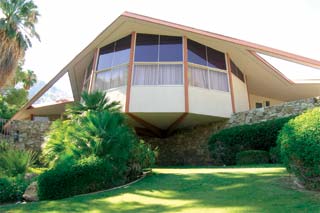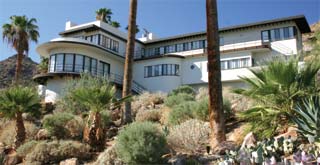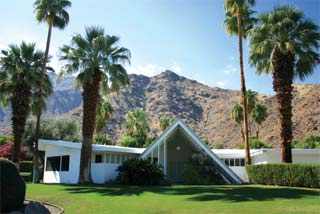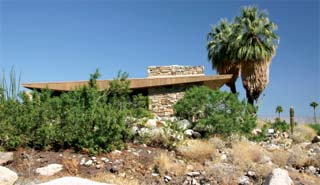Desert Delights - Palm Springs - Page 3
 |
|
'Elvis Honeymoon Hideaway.' Photo: Dave Weinstein |
 |
|
|
 |
|
|
 |
|
|
Palm Springs was taken over by the military during the war, but sprung to life immediately after. Bill Cody designed the angular Del Marcos Hotel in 1946, the same year Paul Williams and Quincy Jones designed the Palm Springs Tennis Club. Golf had not yet supplanted tennis. 1946 also saw the Kaufmann house. In 1947 Stew Williams, who moved to Palm Springs in 1946, did his home for Sinatra.
Modernism had arrived. It flourished in the early '50s when many of the public and commercial buildings that still give Palm Springs its modern character were created. Palm Springs was becoming a city. Soon it would have houses for its workers.
George and Robert Alexander, father and son, arrived from Los Angeles in 1955. The Alexander's first project in the desert was the Ocotillo Lodge at the south end of town. Next to it came their first subdivision, Twin Palms Estates. It established the Alexander formula - square houses up to 2,000 square feet that look long and rectangular thanks to a street frontage that fools the eye. "Parking, breezeway, windows, wall," is how Imber puts it. The open breezeway between carport and house is an Alexander trademark that was much copied. So was the Alexanders' use of concrete screens and stone walls to enliven facades.
But nothing so defines Alexanders as their jazzy roofs. Flat, low gabled, butterfly or zigzag, the roofs add variety and a touch of fun to neighborhoods that are composed of essentially the same house. No one visiting an Alexander neighborhood should neglect the stone walls or stone facades, or concrete screens and walls. Many are works of art. The Alexanders' most unique development was a group of seven steel homes designed in 1961. The goal was to build an entire neighborhood, but the price of steel rose and the project died. The neighborhood is a Palm Springs historic district.
By the 1970s, Palm Springs was on the skids. Stew Williams blamed the city's rejection of his proposed modern downtown master plan. Others blamed the growth of gated golf club communities 'down valley' in Rancho Mirage and Palm Desert. Modern buildings continued to be built - including such landmarks as John Lautner's flying saucer home for Bob Hope, and Cody's beautiful St. Theresa Catholic Church. But others were ignored. Imber remembers when Neutra's Miller residence housed derelicts.
By the late 1990s, however, Palm Springs was back - thanks in part to its modern architecture. Several major remodels - of the Kaufmann house, the Loewy house - reminded people of the architecture's beauty. A successful fight to preserve Frey's Tramway gas station and his fire station buoyed mid-century fans. Motels are cleaning themselves up and installing Eames chairs and Noguchi tables. Shops selling vintage modern can be found everywhere.
Jim Isermann, a member of the city's Historic Site Preservation Board, says, "When I started there were only six people in town who cared. Now there are a ton of people." But several of the city's modern landmarks remain in danger - and may be beyond rescue. Imber shudders when he walks past Paul R. Williams' and Quincy Jones' Town and Country Center, a retail plaza that has lost its looks.
Isermann is encouraged by some of the younger architects, like O'Donnell Escalante Architects, who are creating buildings that are rooted in the desert tradition. "We are getting wonderful contemporary designs," he says, "based on mid-century principles."




